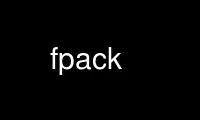
This is the command fpack that can be run in the OnWorks free hosting provider using one of our multiple free online workstations such as Ubuntu Online, Fedora Online, Windows online emulator or MAC OS online emulator
PROGRAM:
NAME
fpack - FITS image compression program
SYNOPSYS
funpack [OPTION]... FILE...
DESCRIPTION
fpack is a utility program for optimally compressing images in the FITS data format. This
programs is analogous to the GZIP utility program except that it is optimized for FITS
format images and offer a wider choice of compression options.
OPTIONS
Flags must be separate and appear before filenames. Use '-' to read from stdin.
The compression parameters specified on the fpack command line may be overridden by
compression directive keywords in the header of each HDU of the input file(s).
-r Rice compression (default).
-h Hcompress compression.
-g or -g1 GZIP_1 (per-tile) compression.
-g2 GZIP_2 (per-tile) compression (with byte shuffling).
-p PLIO compression (only for positive 8 or 16-bit integer images).
-d Tile the image without compression (debugging mode).
-w Compress the whole image as a single large tile.
-t axes
Comma separated list of tile dimensions (default is row by row).
-q level
Quantized level spacing when converting floating point images to scaled integers.
(+value relative to sigma of background noise; -value is absolute). Default q value
of 4 gives a compression ratio of about 6 with very high fidelity (only 0.26%
increase in noise). Using q values of 2, or 1 will give compression ratios of
about 8, or 10, respectively (with 1.0% or 4.1% noise increase). The scaled
quantized values are randomly dithered using a seed value determined from the
system clock at run time. Use -q0 instead of -q to suppress random dithering. Use
-qz instead of -q to not dither zero-valued pixels. Use -qt or -qzt to compute
random dithering seed from first tile checksum. Use -qN or -qzN, (N in range 1 to
10000) to use a specific dithering seed. Floating-point images can be losslessly
compressed by selecting the GZIP algorithm and specifying -q 0, but this is slower
and often produces much less compression than the default quantization method.
-i2f Convert integer images to floating point, then quantize and compress using the
specified q level. When used appropriately, this lossy compression method can give
much better compression than the normal lossless compression methods without
significant loss of information. The -n3ratio and -n3min flags control the minimum
noise thresholds; Images below these thresholds will be losslessly compressed.
-n3ratio
Minimum ratio of background noise sigma divided by q. Default = 2.0.
-n3min Minimum background noise sigma. Default = 6. The -i2f flag will be ignored if the
noise level in the image does not exceed both thresholds.
-s scale
Scale factor for lossy Hcompress (default = 0 = lossless) (+values relative to RMS
noise; -value is absolute)
-n noise
Rescale scaled-integer images to reduce noise and improve compression.
-v Verbose mode; list each file as it is processed.
-T Show compression algorithm comparison test statistics; files unchanged.
-R file
Write the comparison test report (above) to a text file.
-table Compress FITS binary tables using prototype method, as well as compress any image
HDUs. This option is intended for experimental use.
-tableonly
Compress only FITS binary tables using prototype method; do not compress any image
HDUs. This option is intended for experimental use.
-F Overwrite input file by output file with same name.
-D Delete input file after writing output.
-Y Suppress prompts to confirm -F or -D options.
-S Output compressed FITS files to STDOUT.
-L List contents; files unchanged.
-C Don't update FITS checksum keywords.
-H Show this message.
-V Show version number.
Use fpack online using onworks.net services
